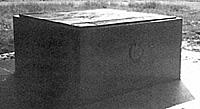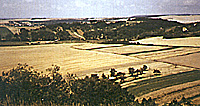The Battle of Austerlitz
2 December 1805
Brief Summary of the Campaign
text and photos by John Salmon, UK
| |
AAusterlitz, for any student of the Napoleonic era the name conjures up visions of marching columns, charging cavalry and the thunder of cannon.
At right, monument of Napoleon's command post on the Zurlan Heights.
Walking over the ground brings these images to life, I hope this article and accompanying photographs will allow the reader to share some of the excitement I felt simply by being there.
The March to Austerlitz
On 25 August 1805 the first French units left their camps near the English Channel and started the long march towards the heart of Europe. Napoleon was abandoning his plans for an invasion of Great Britain and was turning against her continental allies Austria and Russia. Other French forces scattered around northern Germany and eastern France joined in the manoeuvre. The immediate prize was the Austrian forces under General Mack who had advanced into Bavaria and occupied Ulm. By dint of swift marches and bold strategic manoeuvres Mack's force was surrounded and some 60,000 men and 200 cannon were forced to surrender on 20 October. Co-ordination between the Austrians and Russians was to say the least poor, the fact that they were working on two different calendars with a 9 day gap between dates led to a disaster from which the allies never recovered from. On the very next day Nelson would inflict a devastating defeat on the combined French and Spanish navies at Trafalgar, but the strategic effects of that victory would be felt only in succeeding years, Austrian capitulation at Ulm was of immense value to the French immediately.
With Mack's forces neutralised Napoleon marched on the Russians under Kutusov. Napoleon censured Murat for being tricked by the Russian rearguard commander Bagration into accepting an armistice after the battle of Hollabrünn on the 16 November. This allowed the Russians to escape to the north bank of the Danube and effect a junction in northern Moravia (the eastern part of the Czech Republic), between the forces of Kutusov and reinforcements marching from Russia under Buxhöwden. The French were now in a dangerous strategic position: they were 700 miles from their bases in eastern France facing a larger combined Austrian/Russian army, they were exhausted after months of hard marching, in northern Italy a large Austrian army under the Arch Duke Charles was dis engaging from French forces under Massena and marching against Napoleon's rear, to cape it all rumours were circulating that the Prussians, who had been neutral, were moving towards the allied cause.
If that happened Napoleon would be surrounded by three armies each larger than his own. Ever the gambler Napoleon decided that salvation lay in a crushing victory over the Austro/Russian army under Kutusov in Moravia. Defeat of this army would have the additional advantage that the Austrian Emperor Frances and the Russian Emperor Alexander were with it. If either of these emperors could be overawed by defeat in the field they might well seek terms from a victorious Napoleon.
Battle plans
In late November Napoleon brought his army to the hills and lakes in the area west of the small town of Austerlitz. Although he had started the campaign with over 300,000 troops diversions such as guarding supply lines, garrisons and the shear wastage caused by such a rapid advance meant that Napoleon had only 73,200 men and 139 guns available for his immediate field force.1 At first the French occupied an extended front which included the large area known as the Pratzen Heights, but Napoleon had other plans for these hills. They would become a trap into which the allies would fall. Undoubtedly the Pratzen Heights dominated the area, provided a thick mist was not smothering the lower ground and hiding any troops that were manoeuvring there. On the mornings before the battle Napoleon had noted how the mist lay in the valleys around the Pratzen, he would use these mists to cocoon the allies in the thick confusing fog of war. He would allow the allies to think that they had the initiative, he hoped that by withdrawing his men from the Pratzen he would lull them into a false sense of security.
The Emperor's aim was to deceive the allies into believing that he was weaker than he actually was. The allies would then be tempted into some bold manoeuvres that Napoleon could then exploit. He initially planned to show a weakened southern flank and tempt the Allies into stripping their centre on the Pratzen to attack this tempting target. Napoleon knew that hard marching Davout was moving up from the south with reinforcements which would bolster his southern flank. Once in charge of the Pratzen he could then turn against the Allied northern flank. Events would not work out quite as the Emperor foresaw, he would have to use his skills as a commander and improvise, produce an even more devastating result than he had originally envisaged. The initial part of his deception was to pull back his troops from the Heights and on the 1 December the Allies, overjoyed at this sight of weakness, eagerly moved forwarded to occupy them.
To the south was Legrand, part of Soult's corps, spread out in a thin line occupying the villages of Zokolnitz and Telnitz bolstered at the southern most extremity by the frozen lakes or ponds of the Satschan Mere. This area would be vulnerable until Davout's forces arrived. On the night of the 1 December Napoleon inspected a part of his army, his troops formed the now famous torch light parade by lighting his way with burning strands of straw. Just one year before he had proclaimed himself their Emperor, now he would lead them in a battle that would be justifiably hailed as one of his and their greatest victories.
Facing him was a combined Austro Russian force consisting of some 85,400 men and 278 guns commanded by General Kutusov. This wily old general had the added complication of entertaining both his own Emperor Alexander and the Austrian Emperor Frances. Due to the presence of the two monarchs with their retinues of staff officers Kutusov had to weight heavily the suggestions for actions that emanated from the imperial courts. He was by no-means a free agent able to formulate his own plans as Napoleon was. The plan proposed by the Austrian General Weyrother was one of complex manoeuvre that was supposed to blind and intimidate the French with is brilliance. Instead it befuddled and confused the Austro/Russians into making strategic errors that Napoleon would seize upon with a ruthless mastery of the Art of war. Under this plan General Buxhowden was to manoeuvre a force of some 45,000 men across the slopes of the Pratzen Heights and strike the French southern flank, cutting it off from their communications with Vienna. This massive force was then supposed to hook northwards behind the French centre and roll it up. Another force was to hold the Pratzen Heights and attack the French centre in conjunction with Buxhöwden's manoeuvre on their rear. General Bagration was to attack the French in the north the while Russian Imperial guard was to form a reserve near the small town of Austerlitz.
The co-ordination required by this battle plan would have defied the skills and technology of a modern army, it would probably not survive contact with a troop of boy scouts never mind a commander of Napoleon's calibre. Perhaps Kutusov did the wisest thing by catching up on his sleep during the staff meeting when this plan of action was laid before the generals. Whatever his thoughts, between the enthusiasm of his young Emperor and the lateness of the hour no changes to the plan could be made. For good or ill the die was cast.
More Austerlitz
|


 The French position running from north to south covered some five miles. The Santon mount (at right, area to the west of the Santon -- Bernadotte's corp formed up here) dominated the northern area; from its flattened top cannon could sweep the surrounding ground with a withering fire. It served as the base for Lannes corps, to first hold the northern flank and then strike the enemy. Bernadotte's corps could form up behind its shelter and hid their presence from the enemy. Soult's corps, held the middle ground facing the Pratzen Heights, his troops were hidden by the morning mists in the valley below the Heights along the Bosentiz and Goldbach streams. It was just behind these streams on the Zurlan hill that Napoleon set up his command post. On the reverse slopes of the Zurlan Napoleon placed most of his cavalry under Murat, Oudinot's grenadiers and the Imperial Guard.
The French position running from north to south covered some five miles. The Santon mount (at right, area to the west of the Santon -- Bernadotte's corp formed up here) dominated the northern area; from its flattened top cannon could sweep the surrounding ground with a withering fire. It served as the base for Lannes corps, to first hold the northern flank and then strike the enemy. Bernadotte's corps could form up behind its shelter and hid their presence from the enemy. Soult's corps, held the middle ground facing the Pratzen Heights, his troops were hidden by the morning mists in the valley below the Heights along the Bosentiz and Goldbach streams. It was just behind these streams on the Zurlan hill that Napoleon set up his command post. On the reverse slopes of the Zurlan Napoleon placed most of his cavalry under Murat, Oudinot's grenadiers and the Imperial Guard.